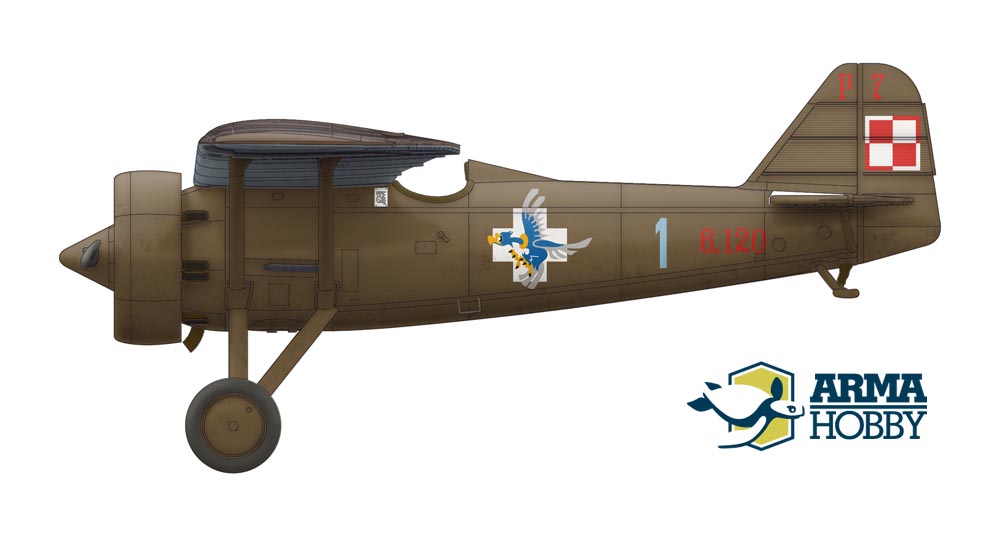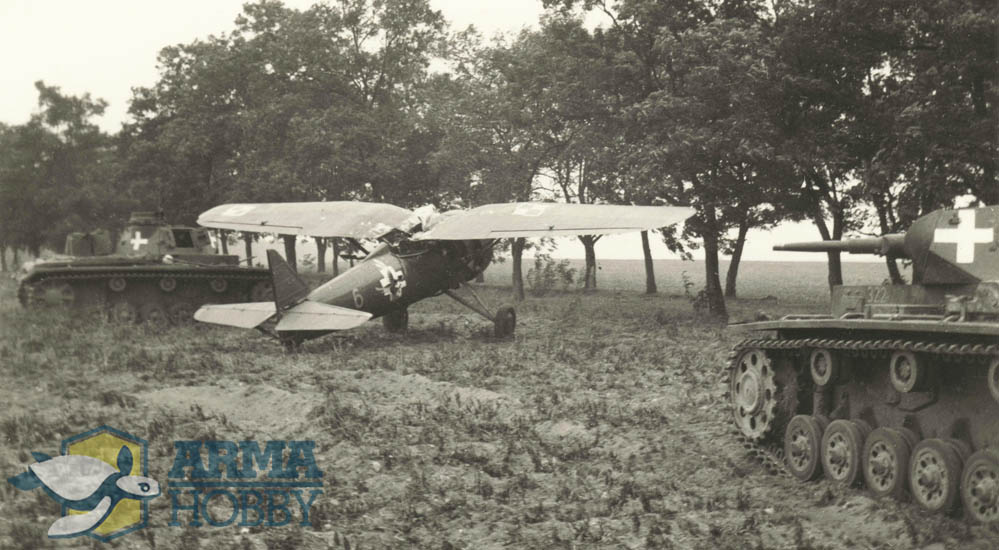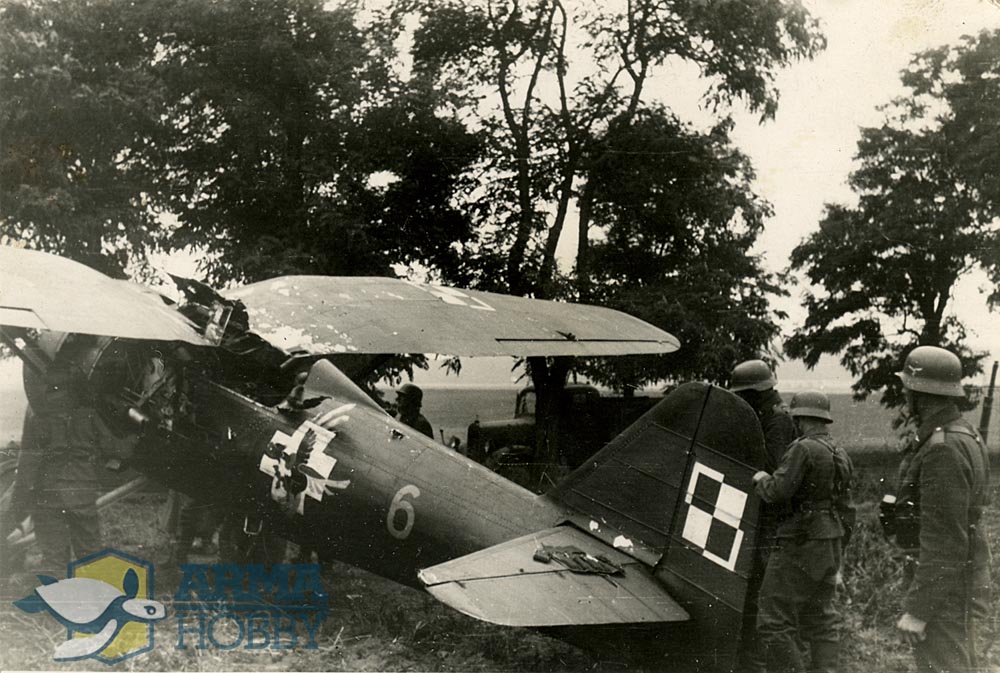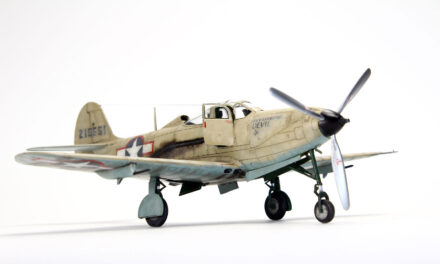Today we present another airplane from PZL P.7a Expert Set 1939 model kit. Aircraft of the elite 151. Fighter Squadron presents spectacular unit insignia and may be displayed on a very interesting diorama setting from 1939 Polish roads. Read the history and see great photos! 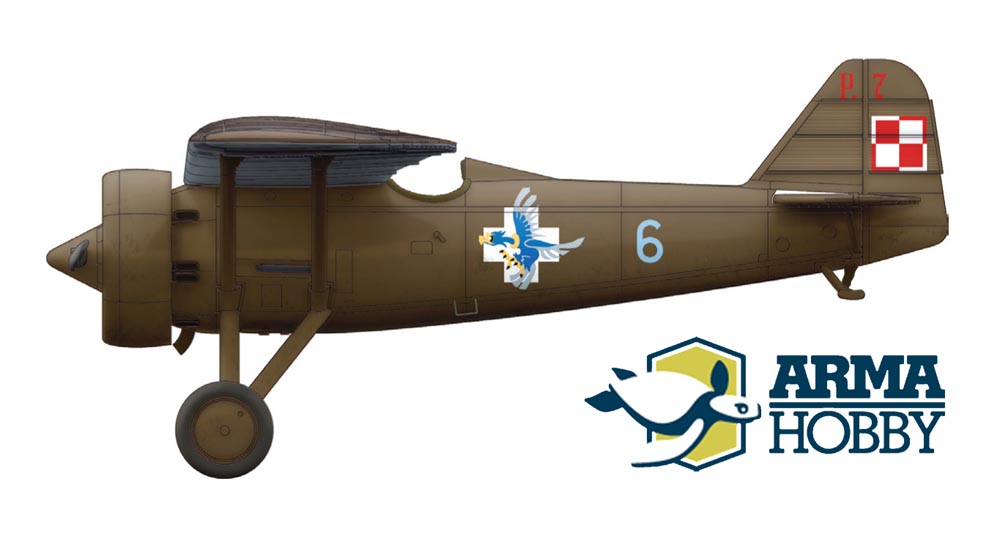
PZL P.7a, 151. Fighter Squadron from City of Wilno, in 1939 attached to the “Narew” Task Force. 2nd Lt. Zygmunt Kinel’s airplane.
Fighters from City of Wilno
III/5 Fighter Wing, consisting of Squadrons 151. and 152. has been formed in the 1937 summer, along with the III/6 City of Lwów Fighter Wing, as the last Polish fighter unit before the start of the war. Its personnel came from the disbanded “third” squadron from Toruń – 143. Fighter Squadron, with addition of the fresh graduates of the pilot schools. During peacetime its base was Wilno-Porubanek airfield. Despite quite short experience, the fighters from Wilno have reached very high skill level. It was proven by the Wing contingent victory in 1938 Central Fighter Aviation Contest. The three winners were: 2nd Lt. Anatol Piotrowski and Cpl. Stanisław Brzeski from 152. and 2nd Lt. Zygmunt Kinel from 151. Sqadron.
Wartime assignment – „Narew” Army Task Force
Mobilization plan for the war against Nazi Germany included split of the Wing and attachment of the separate squadrons to the Armies defending the country North border with East Prussia. Stronger, PZL P.11c equipped 152. Squadron joined the “Modlin” Army and the 151. Squadron, flying older PZL P.7a fighters – the “Narew” Army Task Force. On 31st August the units flew to the frontline airfields, for 151. Sq. it was Biel village near Ostrów Mazowiecka. The squadron, commanded by 1st Lt. Józef Brzeziński, despite the best skills of the crews, was not considered a first-rate unit by the Command. Everybody knew that the obsolete PZL P.7a are no match for the fast German airplanes, so the squadron had lower priority of supply. Because of that till the outbreak of the war only three of its PZLs had their worn and often jamming Vickers machine guns replaced with new PWU wz. 33 guns.
PZL P.7a, 151. Fighter Squadron in 1939. Airplane of the Squadron commander Lt. Józef Brzeziński, Brześć-Adamkowo aifield, September 1939. Markings of this airplane are incuded in 70008 PZL P.7a Junior Set.
September sky
Despite that the orders given to the 151. Squadron on the first day of the war were very challenging. Besides of the maintaining of typical combat air patrol over ground forces of the “Narew” TF, the first mission was escort of the PZL P.23 Karaś bomber from 51. Squadron performing reconnaissance and ground attack sortie over enemy territory of Prussia (Olsztyn and Szczytno cities). The fighters near Myszyniec have spotted and strafed the units of German 1st Cavalry Brigade, and the Karaś bomber has bombed the transport column. This was followed by the reconnaissance of the German airfield near Szczytno. The mission was successful, but the losses inflicted to the Germans were only moderate, because the old Vickers MGs have jammed very quickly. The following days were similar lights and shadows of Army Cooperation unit daily work: strafing of the German cavalry, combat air patrols against enemy reconnaissance and even attacking enemy observation balloons! Such WWI-style mission was performed on 6th September near Polish-defended Różan bridgehead by the 2nd Lt. Zygmunt Kinel, who was unfortunately not able to shot down the balloon due to Vickers MGs jamming. Worn guns were the Squadron’s nightmare, severely limiting its combat value. Despite the ground crews efforts the armament was never fully functioning.
Against Guderian’s tanks
Since 9th September morning the Squadron was stationed on the Brześć-Adamkowo airfield of the famous former Imperial Russian Brześć-Litovsk fortress, at that time used as Polish Army Headquarters. The pilots defended the fortress against the air raids and performed strategic reconnaissance missions for the Supreme Commander. The most important was constant surveillance of the fast-moving armoured forces of the XIXth Corps led by Gen. Heinz Guderian, famous creator of the Blitzkrieg doctrine and brilliant tank commander. These missions were very dangerous due to the heavy and effective anti-aircraft armament of the Panzer-columns. On 11th September piloted by 2nd Lt. Zygmunt Kinel PZL P.7a marked with “6” has been hit by the German flak over the armoured column near Zambrów. The wounded pilot managed to safely land behind friendly lines and was taken to the hospital in Wilno, but the airplane was soon captured by advancing German tanks of the elite Panzer-Lehr-Abteilung (Armoured Battalion manned by the highly skilled tank school’s instructors), the only German unit equipped at that time with the newest Panzer III E tanks. Their crews made some souvenir photos of the tanks near the damaged airplane.
2nd Lt. Kinel’s airplane with two Panzer III E tanks of the Panzer-Lehr-Abteilung. “Souvenir hunters” have already removed the rudder. Photo from dr Tomasz Kopański collection
Zygmunt Kinel’s „The six” – modeller’s view
Marked with the number “6” and the blue condor – unit marking of the 151. Fighter Squadron, the airplane is well documented by the German photos and may be very tempting subject for the modeler, both as a “normal” airplane model or as an interesting diorama with German tanks and trucks as well. The number “6” on the plane side (ordinal number of the plane in the unit) is on the photo visibly darker than the white of the national markings (the checkerboards), it was painted probably in blue (but could have been yellow too). We don’t know the whole serial number, but the part of its dark (red) first digit “6” is barely visible near the tailplane leading edge. Wing undersurfaces are not visible, but we can assume (similarly as on the PZL from the same unit marked with “1”), that the checkerboards had white fields and the big tactical underwing number was not present, and plane was marked only with the letter “L” denoting the 5th Air Regiment from Wilno. Clearly visible are asymmetricaly applied small checkerboards on the wing top surface. The most difficult to determine is presence of the “P 7” type marking on the fin and rudder. One can’t see it on the picture, but the light conditions make this area of the photo not very clear due to the low-contrast – also the red parts of the checkerboard are hard to distinguish from the khaki surroundings. So the decision in this case we leave to the modeler.
2nd Lt. Kinel’s airplane after emergency landing near Zambrów, with the German soldiers of the motorized unit. Photo from dr Tomasz Kopański collection
Diorama with the tanks?
Which of the modellers has not thought about building a diorama with airplane and tanks standing together? In reality such situations are very rare and rather unrealistic. This time we have an exception: the photographs, being historical documentation, justifies placing near your airplane model not only one, but two Panzer III E tanks (very good, though a bit simplified kit is cheaply available in the “First to Fight” series)! Used by the Panzer-Lehr-Abteilung “mark III” tanks were in September 1939 most modern Panzerwaffe equipment. According to the rules these were camouflaged with the dark grey Panzergrau colour with brown fields. White crosses typical for 1939 are clearly visible on the turret, while on the front hull armour these were often covered with mud as they made an excellent aid for the enemy artillery aimers. The tactical numbers were most probably yellow.
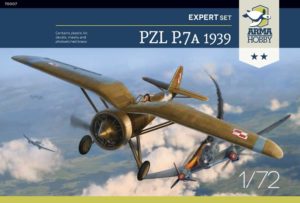 Advertisement
Advertisement
Check out PZL aircraft model kits in Arma Hobby Internet Shop.
Modeller, son and father of a modeller. Loves digging through references and analysing old photographs. He builds aircraft, ship and vehicle models, the older the better. He has a weakness for Polish equipment, but does not despise the RAF, FAA and Great War topics. A journalist by training.
This post is also available in:
 polski
polski


